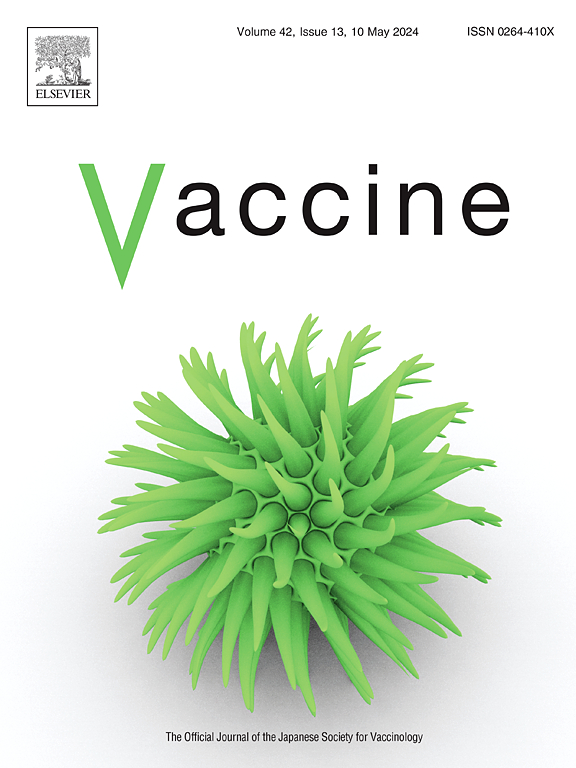COVID-19大流行后疫苗接种意愿逆转的因素:来自全国小组调查的见解。
IF 4.5
3区 医学
Q2 IMMUNOLOGY
引用次数: 0
摘要
疫苗接种在个人和社区层面显示出有效性。为了管理疫苗的需求和供应,有效地促进疫苗接种,并规划未来的疫苗接种策略,了解人口意愿随时间的变化至关重要。疫苗接种意愿的极端变化会影响疫苗供过于求和短缺。很少有纵向研究关注COVID-19大流行后的疫苗接种意愿。因此,我们试图探索COVID-19疫苗接种意愿的时间变化,并确定大流行期间和之后的相关变量。方法:2020年1月至2024年3月在日本进行为期4年的面板调查。为了评估COVID-19疫苗接种意愿的变化并确定相关因素,我们评估了2022年9月的疫苗犹豫(即之前接种过疫苗的个体不希望接受未来疫苗接种)和2024年3月的未逆转疫苗接种意愿(即之前接种过疫苗的个体希望接受未来疫苗接种并希望在2022年9月接受疫苗接种)。采用修正泊松回归检验疫苗犹豫和非逆转接种意愿的预测因子。结果:疫苗接种意愿从2022年9月的51.0%下降到2024年3月的19.9%。男性、对COVID-19的兴趣、风险认知、年龄和对政府政策的认同与疫苗犹豫呈负相关。家庭感染经历成为非逆转疫苗接种意愿的临界显著负性因素。讨论:年轻人群、妇女和对COVID-19认知恐惧风险较低的人群最初的疫苗接种需求可能较低,即使在大流行结束后也可能下降。疫苗需求可能在同一人群中发生变化。因此,根据人口特征重新评估和调整分配策略至关重要。结论:有必要考虑这些相关因素,并随着时间的推移调整疫苗供需平衡,以保持足够的覆盖率,防止资源浪费。本文章由计算机程序翻译,如有差异,请以英文原文为准。
Contributing factors to reversed willingness to vaccinate after the COVID-19 pandemic: Insights from a national panel survey
Introduction
Vaccination shows effectiveness at personal and community levels. To manage vaccine demand and supply, effectively promote vaccination, and plan future vaccination strategies, it is crucial to understand the change in the population's willingness over time. Extreme changes in vaccination willingness can affect vaccine oversupply and shortage. Few longitudinal studies have focused on vaccination willingness after the COVID-19 pandemic. Therefore, we sought to explore temporal changes in COVID-19 vaccination willingness and identify associated variables during and after the pandemic.
Methods
A 4-year panel survey was conducted in Japan between January 2020 and March 2024. To evaluate changes in COVID-19 vaccine willingness and identify associated factors, we assessed vaccine hesitancy in September 2022 (i.e., previously vaccinated individuals who did not wish to receive future vaccinations) and unreversed willingness to vaccinate in March 2024 (i.e., previously vaccinated individuals who wished to receive future vaccinations and wished to receive vaccination in September 2022). Modified Poisson regression was performed to examine the predictors of vaccine hesitancy and unreversed willingness to vaccinate.
Results
Vaccination willingness declined from 51.0 % in September 2022 to 19.9 % in March 2024. Man, interest in COVID-19, risk perception, age, and agreement with government policies were negatively associated with vaccine hesitancy. Family experience of infection emerged as a borderline-significant negative factor in unreversed willingness to vaccinate.
Discussion
Populations with younger populations, women, and people with low dread risk of perception for COVID-19 may have a low initial vaccination demand, which may decrease even after the pandemic ends. Vaccine demand may change within the same population. Therefore, it is crucial to reassess and adjust distribution strategies based on population characteristics.
Conclusion
It is essential to consider these associated factors and adjust the balance between vaccine supply and demand over time to maintain adequate coverage and prevent waste of resources.
求助全文
通过发布文献求助,成功后即可免费获取论文全文。
去求助
来源期刊

Vaccine
医学-免疫学
CiteScore
8.70
自引率
5.50%
发文量
992
审稿时长
131 days
期刊介绍:
Vaccine is unique in publishing the highest quality science across all disciplines relevant to the field of vaccinology - all original article submissions across basic and clinical research, vaccine manufacturing, history, public policy, behavioral science and ethics, social sciences, safety, and many other related areas are welcomed. The submission categories as given in the Guide for Authors indicate where we receive the most papers. Papers outside these major areas are also welcome and authors are encouraged to contact us with specific questions.
 求助内容:
求助内容: 应助结果提醒方式:
应助结果提醒方式:


